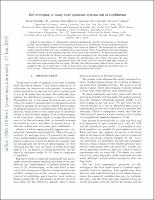Please use this identifier to cite or link to this item:
https://hdl.handle.net/20.500.12202/4844Full metadata record
| DC Field | Value | Language |
|---|---|---|
| dc.contributor.author | Schiulaz, Mauro | |
| dc.contributor.author | Torres-Herrera, E. Jonathan | |
| dc.contributor.author | Pérez-Bernal, Francisco | |
| dc.contributor.author | Santos, Lea F. | |
| dc.date.accessioned | 2020-01-07T20:35:14Z | |
| dc.date.available | 2020-01-07T20:35:14Z | |
| dc.date.issued | 2019-06-27 | |
| dc.identifier.citation | Schiulaz, Mauro ; Torres-Herrera, E. Jonathan ; Pérez-Bernal, Francisco ; Santos, Lea F. | en_US |
| dc.identifier.uri | https://arxiv.org/pdf/1906.11856.pdf | en_US |
| dc.identifier.uri | https://hdl.handle.net/20.500.12202/4844 | |
| dc.description | Scholarly article (pre-print) | en_US |
| dc.description.abstract | Despite its importance to experiments, numerical simulations, and the development of theoretical models, self-averaging in many-body quantum systems out of equilibrium remains underinvestigated. Usually, in the chaotic regime, self-averaging is just taken for granted. The numerical and analytical results presented here force us to rethink these expectations. They demonstrate that self-averaging properties depend on the quantity and also on the time scale considered. We show analytically that the survival probability in chaotic systems is not self-averaging at any time scale, even when evolved under full random matrices. We also analyze the participation ratio, Rényi entropies, the spin autocorrelation function from experiments with cold atoms, and the connected spin-spin correlation function from experiments with ion traps. We find that self-averaging holds at short times for the quantities that are local in space, while at long times, self-averaging applies for quantities that are local in time. Various behaviors are revealed at intermediate time scales. | en_US |
| dc.description.sponsorship | ACKNOWLEDGMENTS M.S. and L.F.S. are supported by the NSF Grant No. DMR-1603418. E.J.T.-H. acknowledges fund-ing from VIEP-BUAP (Grant Nos. MEBJ-EXC19-G, LUAGEXC19-G), Mexico. He is also grateful to LNS-BUAP for allowing use of their supercomputing facil-ity. F.P.B. thanks the Consejer´ıa de Conocimiento, Investigaci´on y Universidad, Junta de Andaluc´ıa and European Regional Development Fund (ERDF), ref. SOMM17/6105/UGR. Additional computer resources supporting this work were provided by the Universidad de Huelva CEAFMC High Performance Computer lo-cated in the Campus Universitario el Carmen and funded by FEDER/MINECO project UNHU-15CE-2848. Part of this work was performed at the Aspen Center for Physics, which is supported by National Science Foun-dation grant PHY-1607611. | en_US |
| dc.language.iso | en_US | en_US |
| dc.publisher | arXiv.org | en_US |
| dc.relation.ispartofseries | Statistical Mechanics (cond-mat.stat-mech);arXiv:1906.11856v1 | |
| dc.rights | Attribution-NonCommercial-NoDerivs 3.0 United States | * |
| dc.rights.uri | http://creativecommons.org/licenses/by-nc-nd/3.0/us/ | * |
| dc.subject | self-averaging | en_US |
| dc.subject | many-body quantum systems | en_US |
| dc.title | Self-averaging in many-body quantum systems out of equilibrium. | en_US |
| dc.type | Article | en_US |
| dc.contributor.orcid | 0000-0001-9400-2709 | |
| local.yu.facultypage | https://www.yu.edu/faculty/pages/santos-lea | |
| Appears in Collections: | Stern College for Women -- Faculty Publications | |
Files in This Item:
| File | Description | Size | Format | |
|---|---|---|---|---|
| Santos self-averaging in many-body 1906.11856.pdf | arXiv.org | 1.81 MB | Adobe PDF |  View/Open |
This item is licensed under a Creative Commons License

